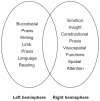Intuition, insight, and the right hemisphere: Emergence of higher sociocognitive functions
- PMID: 22110327
- PMCID: PMC3218761
- DOI: 10.2147/prbm.s7935
Intuition, insight, and the right hemisphere: Emergence of higher sociocognitive functions
Abstract
Intuition is the ability to understand immediately without conscious reasoning and is sometimes explained as a 'gut feeling' about the rightness or wrongness of a person, place, situation, temporal episode or object. In contrast, insight is the capacity to gain accurate and a deep understanding of a problem and it is often associated with movement beyond existing paradigms. Examples include Darwin, Einstein and Freud's theories of natural selection, relativity, or the unconscious; respectively. Many cultures name these concepts and acknowledge their value, and insight is recognized as particularly characteristic of eminent achievements in the arts, sciences and politics. Considerable data suggests that these two concepts are more related than distinct, and that a more distributed intuitive network may feed into a predominately right hemispheric insight-based functional neuronal architecture. The preparation and incubation stages of insight may rely on the incorporation of domain-specific automatized expertise schema associated with intuition. In this manuscript the neural networks associated with intuition and insight are reviewed. Case studies of anomalous subjects with ability-achievement discrepancies are summarized. This theoretical review proposes the prospect that atypical localization of cognitive modules may enhance intuitive and insightful functions and thereby explain individual achievement beyond that expected by conventionally measured intelligence tests. A model and theory of intuition and insight's neuroanatomical basis is proposed which could be used as a starting point for future research and better understanding of the nature of these two distinctly human and highly complex poorly understood abilities.
Keywords: House–Tree–Person; IQ threshold theory; achievement–ability discrepancy; anomalous functions; atypical localization of cognitive functions; clinical intuition; clinical psychology; crossed aphasia; crosslinguistic fluency; drawings; emergent properties; functional capacity; insight; intuition; inverse cognitive modeling; nonverbal decoding; nonverbal sequencing; right hemisphere dominance; specialization; unconscious and conscious processes; visual gesture lexicon.
Figures








Similar articles
-
Evidence in clinical reasoning: a computational linguistics analysis of 789,712 medical case summaries 1983-2012.BMC Med Inform Decis Mak. 2015 Mar 21;15:19. doi: 10.1186/s12911-015-0136-8. BMC Med Inform Decis Mak. 2015. PMID: 25880840 Free PMC article.
-
Intuition in clinical decision-making: a psychological penumbra.Int J Palliat Nurs. 2008 Oct;14(10):492-6. doi: 10.12968/ijpn.2008.14.10.31493. Int J Palliat Nurs. 2008. PMID: 18978695 Review.
-
Intuitive decision making as a gradual process: investigating semantic intuition-based and priming-based decisions with fMRI.Brain Behav. 2015 Dec 22;6(1):e00420. doi: 10.1002/brb3.420. eCollection 2016 Jan. Brain Behav. 2015. PMID: 27110441 Free PMC article.
-
Role of intuitive knowledge in the diagnostic reasoning of hospital specialists: a focus group study.BMJ Open. 2019 Jan 28;9(1):e022724. doi: 10.1136/bmjopen-2018-022724. BMJ Open. 2019. PMID: 30696671 Free PMC article.
-
Approaching the Distinction between Intuition and Insight.Front Psychol. 2016 Aug 9;7:1195. doi: 10.3389/fpsyg.2016.01195. eCollection 2016. Front Psychol. 2016. PMID: 27555833 Free PMC article. Review.
Cited by
-
Personality, Stress, and Intuition: Emotion Regulation Abilities Moderate the Effect of Stress-Dependent Cortisol Increase on Coherence Judgments.Front Psychol. 2020 Feb 27;11:339. doi: 10.3389/fpsyg.2020.00339. eCollection 2020. Front Psychol. 2020. PMID: 32174877 Free PMC article.
-
Dissociable Posterior and Anterior Insula Activations in Processing Negative Stimulus Before and After the Application of Cognitive Reappraisals.Front Psychol. 2020 Mar 3;11:268. doi: 10.3389/fpsyg.2020.00268. eCollection 2020. Front Psychol. 2020. PMID: 32194473 Free PMC article.
-
Hunches that matter: the role of intuitive concern in medical understanding.Front Psychol. 2025 Jul 2;16:1508138. doi: 10.3389/fpsyg.2025.1508138. eCollection 2025. Front Psychol. 2025. PMID: 40672851 Free PMC article.
-
Real-time biofeedback integrated into neuromuscular training reduces high-risk knee biomechanics and increases functional brain connectivity: A preliminary longitudinal investigation.Psychophysiology. 2020 May;57(5):e13545. doi: 10.1111/psyp.13545. Epub 2020 Feb 13. Psychophysiology. 2020. PMID: 32052868 Free PMC article.
-
Visual Puzzles, Figure Weights, and Cancellation: Some Preliminary Hypotheses on the Functional and Neural Substrates of These Three New WAIS-IV Subtests.ISRN Neurol. 2011;2011:123173. doi: 10.5402/2011/123173. Epub 2011 Aug 23. ISRN Neurol. 2011. PMID: 22389807 Free PMC article.
References
-
- Lindell AK. In your right mind: Right hemisphere contributions to language processing and production. Neuropsychol Rev. 2006;16:131–148. - PubMed
-
- Beeman M, Chiarello C, editors. Right Hemisphere Language Comprehension: Perspectives from Cognitive Neuroscience. Mahwah, NJ: Erlbaum; 1998.
-
- Luria AR. Higher Cortical Functions in Man. New York, NY: Basic Books; 1966.
-
- Lenneberg E. Biological Foundations of Language. New York, NY: Wiley; 1967.
-
- Floel A, Jansen A, Deppe M, et al. Atypical hemispheric dominance for attention: Functional MRI topography. J Cereb Blood F Met. 2005;25:1197–1208. - PubMed
Grants and funding
LinkOut - more resources
Full Text Sources

